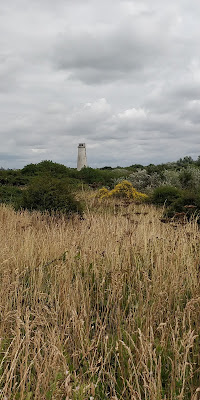 |
| Redshanks and turnstone, Leasowe |
I had a day at the seaside. I'd decided that I needed to get baffled by waders for a few hours and headed off over to the Wirral for a walk between Leasowe and Hoylake.
Walking down towards Leasowe Lighthouse, Kerr's Field was very quiet by its standards, just a few magpies, goldfinches and woodpigeons. A moment's excitement was a female sparrowhawk being seen on its way by a flock of swallows. Aside from a lone chiffchaff calling from the trees by the houses I didn't bump into a warbler all day.
 |
| Leasowe Common |
I walked past the lighthouse and onto the common. Small flocks of goldfinches, linnets and greenfinches twittered in the thistles in the fields and family parties of blue tits and great tits called to each other in the willows around the pond.
It was near low tide when I got to the sea front. A couple of dozen little egrets stood preening on the sands, a couple more hunted in the small pools near the embankment.
 |
| Little egret, Leasowe |
There were plenty of waders about. The curlews and oystercatchers were quite far out, beyond the large groups of lesser black-backs and herring gulls loafing on the higher sandbars. Close to the embankment small flocks of redshanks congregated at the edges of pools to feed and preen. It was good to be able to add the couple of turnstones amongst them to the year list.
 |
| Redshanks, Leasowe |
 |
| Little egret, Meols |
Walking past the groyne there was a subtle shift in the birdlife. I've seen this before but can't explain it. This time, all of a sudden there were lots of black-headed gulls instead of just odd ones and twos. The groups of redshanks were smaller and the curlews and oystercatchers were closer to hand.
 |
| Greenshank, redshanks and black-headed gulls, Meols |
 |
| Meols beach |
There were sand yacht races going on on the sands at Hoylake so I called it quits once I got to the lifeboat station and got the train at Manor Road.













































